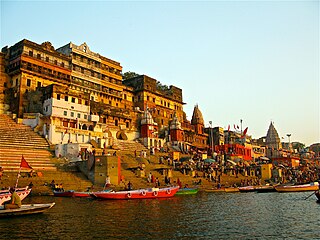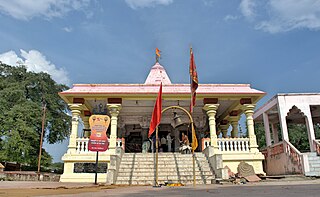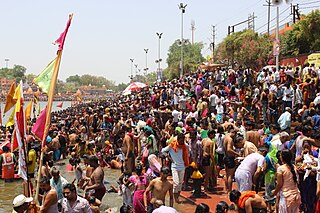
Malwa is a historical region of west-central India occupying a plateau of volcanic origin. Geologically, the Malwa Plateau generally refers to the volcanic upland north of the Vindhya Range. Politically and administratively, it is also synonymous with the former state of Madhya Bharat which was later merged with Madhya Pradesh. At present the historical Malwa region includes districts of western Madhya Pradesh and parts of south-eastern Rajasthan. Sometimes the definition of Malwa is extended to include the Nimar region south of the Vindhyas.

Ujjain or Ujjayinī is a city in Ujjain district of the Indian state of Madhya Pradesh. It is the fifth-largest city in Madhya Pradesh by population and is the administrative centre of Ujjain district and Ujjain division. It is one of the Hindu pilgrimage centres of Sapta Puri famous for the Kumbh Mela (Simhastha) held there every 12 years. The famous temple of Mahakaleshwar Jyotirlinga is located in the center of the city. The city has been one of the most prominent trade and political centres of the Indian Subcontinent from the time of the ancient Mahājanapadas until the British colonisation of India.

Dhar is a city located in Dhar district of the Malwa region in the state of Madhya Pradesh, India. The city is the administrative headquarters of the Dhar district. Before Indian independence from Great Britain, it was the capital of the Dhar princely state.

Vidisha is a city in central Madhya Pradesh, India. It is located 62.5 km northeast of the state capital, Bhopal. The name "Vidisha" is derived from the nearby river "Bais", mentioned in the Puranas.

Shajapur District is a district of Madhya Pradesh state of central India. The town of Shajapur is the district headquarters. It belongs to Ujjain Division.

Ujjain district is a district of Madhya Pradesh state in central India. The historic city of Ujjain is the district headquarters. The district has an area of 6,091 km2, and a population of 19,86,864, a 16.12% increase from its 2001 population of 17,10,982.

Mahadaji Shinde, later known as Mahadji Scindia or Madhava Rao Scindia, was a Maratha statesman and general who served as the Maharaja of Gwalior from 1768 to 1794. He was the fifth and the youngest son of Ranoji Rao Scindia, the founder of the Scindia dynasty. He is reputed for having restored the Maratha rule over North India and for modernizing his army.

Jayajirao Scindia GCB, GCSI, CIE of the Scindia dynasty of Maratha Confederacy was the last independent ruling Maharaja of Gwalior State during the British rule from 1843 to 1886.

The Gwalior State was a state within the Maratha Confederacy located in Central India. It was ruled by the House of Scindia, a Hindu Maratha dynasty. Following the dissolution of the Confederacy, it became part of the Central India Agency of the Indian Empire under British protection.

Shujalpur is a city and a municipality in Shajapur district in the Indian state of Madhya Pradesh. Ranoji Rao Shinde, father of Mahadji Shinde (Scindia), died in 1745 at Shujalpur, where his cenotaph (chattri) stands which houses a Shiv temple. It is known as Ranoganj.

Agar is a town with a municipal government in the state of Madhya Pradesh, India. It is the administrative headquarters for the Agar Malwa District which was formed in 2013 from a part of Shajapur District. The town is situated along the Ujjain—Kota SH-27 highway.

The Sapta Puri are a group of seven Hindu tirtha, or holy pilgrimage sites, located in India. Pilgrimage to these sites is said to bless the pilgrim with moksha.
Chintaman Ganesh is the biggest temple of Lord Ganesha in Ujjain of Madhya Pradesh, India. This temple is built across the Kshipra river on the Fatehabad railway line, and is located about 7 km far south-westerly to the Ujjain town. The temple is located now in the middle of the town's market.

Ghats in Varanasi are riverfront steps leading to the banks of the Ganges river. The city has 84 ghats. Most of the ghats are bathing and puja ceremonial ghats, while two ghats, Manikarnika and Harishchandra, are used exclusively as cremation sites.

Tukoji Rao Holkar, belonging to the Holkar clan of the Marathas was the feudatory of Indore. Tukoji Holkar was the adopted son of Malhar Rao Holkar, he was the second son of Shrimant Tanuji Holkar, a nephew of Malhar Rao Holkar. Thus he was also the grand-nephew of Malhar Rao Holkar. He married two wives. He had four sons Kashi Rao, Malhar Rao II Holkar, Yashwant Rao, and Vithoji Rao.
Gopal Mandir also called as Dwarkadhish temple is the second largest temple of Ujjain after Mahakaleshwar and is dedicated to Lord Krishna, in Ujjain City, Ujjain Division, Madhya Pradesh, India. It was built by Bayaji bai Shinde, the wife of Maratha King Daulatrao Scindia in the 19th century in Maratha Style. It is located in the main market of Ujjain.

Kal Bhairav temple is a Hindu temple located in the Ujjain city of Madhya Pradesh, India. It is dedicated to Kal Bhairav, the guardian deity of the city. Located on the banks of the Shipra River, it is one of the most active temples in the city, visited by hundreds of devotees daily. Liquor is one of the offerings made to the temple deity.

Ujjain Simhastha is a Hindu religious mela held every 12 years in the Ujjain city of Madhya Pradesh, India. The name is also transliterated as Sinhastha or Singhastha. In Hindi, the fair is also called Simhasth or Sinhasth. The name derives from the fact that it is held when the Jupiter is in Leo.
Semliya is a small village/hamlet 4 kilometres (2.5 mi) east of Namli in Ratlam district in the Indian state of Madhya Pradesh.
Lakshmikarna, also known as Karna, was a ruler of the Kalachuri dynasty of Tripuri in central India. His kingdom was centered around the Chedi or Dahala region in present-day Madhya Pradesh.























